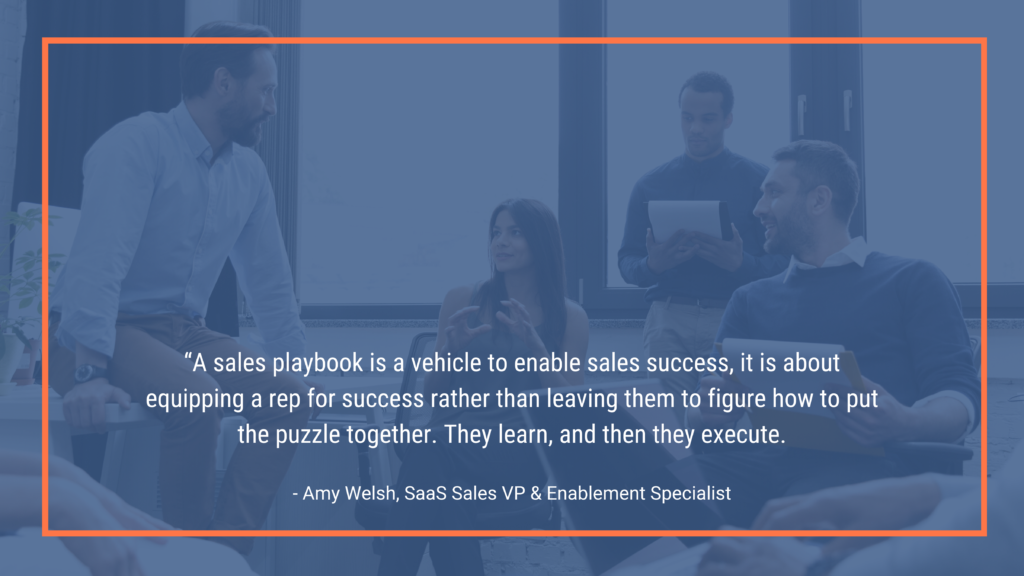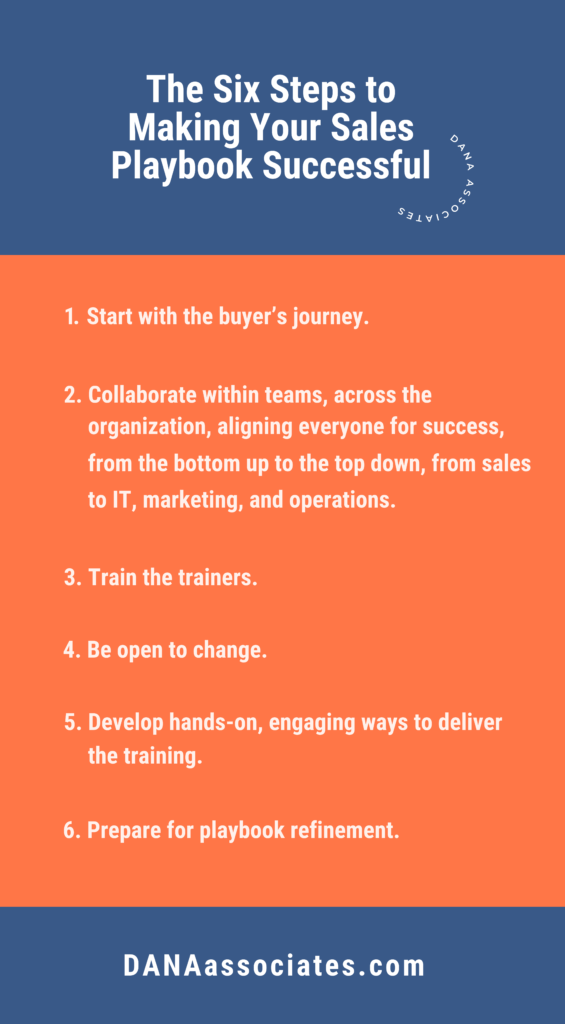
Sales playbooks fit into a comprehensive enablement strategy. They play a pivotal role in detailing and outlining the best practices, procedures, techniques, and strategic sales planning throughout the process. A well-constructed sales playbook equips reps to be effective in achieving goals and providing appropriate and targeted customer outcomes for your products and services.
“A playbook is a vehicle to enable sales success,” said Amy Welsh, SaaS sales VP and enablement specialist. Welsh’s background is in technology software solutions sales. “The sales playbook is about equipping a rep for success rather than leaving them to figure how to put the puzzle together. They learn, and then they execute.”

Welsh has written playbooks at varying sized companies, with widely disparate environments, from start-ups to established companies. She’s seen how a playbook can help with strategic sales planning:
- Improve productivity.
- Make sales teams more accountable and effective.
- Drive revenue through increased closings with greater forecast accuracy.
- Are valuable to start-ups and other high-growth companies in figuring how to convert leads into deals.
- Help salespeople work smarter and faster so they can ultimately turn more prospects into customers.
No two company’s playbooks look the same, but with Welsh’s help, in this article, we look at components of a winning playbook to equip your customer-facing roles with the tools to be valuable, relevant, and differentiating at every step of the buyer’s journey; and what can get in the way of success.
What Key Components are Included in a Sales Playbook?
“When I’m working with a client, the question I ask is, tell me what does it take? What is your approach, your target, your objectives, and what does success look like?” Welsh said. “Depending on the answer, that is how I’m going to prioritize and organize what I put in a playbook.”
The mistake, she said, is throwing everything you possibly can into the playback. It’s comprehensive, but it’s also targeted. “You have to create a playbook from the lens of what will make the salesperson successful, what will give them traction,” Welsh said.
Product and Services Overview + Value Proposition(s). Sales reps need to know what they are selling, in detail: How the products and services will be delivered, and the value of those products and services to potential customers.
Ideal Customer Profiles (ICPs) and Buyer Personas. At the ground level of sales playbook development is mapping out the ICP, identifying the buyer personas, and understanding the buyer’s journey. Sales reps need to understand the customer — their specific needs, interests, and method of buying — to specifically apply and customize your marketing content. The ICPs describe the ideal target business (the companies you will sell to); and the buyer personas build highly researched profiles (or segmented profiles) to help your reps understand why and how customers buy your products and services.
Strategic Sales Planning. They know the product, they know the ideal customer, and now the reps need to know the strategic sales planning process adopted by the organization. A sales process is a set of repeatable steps that a salesperson takes to a prospective buyer, starting from the early stage of awareness and going through to a closed sale. Knowing what each step entails helps salespeople to understand where they are in the process, when it’s time to move to the next step, and when to adjust course. It’s important that the sales process aligns to the way the customer wants to buy (otherwise known as the buyer’s journey), not the way the company wants to sell.
Competitive Analyses. Know the customer and know the competition. An evaluation of competitors’ products, services, and marketing tactics provides sales reps with a “road map needed to capture a greater share of the market and better understand the future trends that will affect your sector.”
Talk Tracks and Objections. Being prepared includes thinking ahead to the sales call. A talk tracks checklist ensures sales reps cover the necessary ground and acquire all the information needed to move qualified prospects through the next stage of the funnel. Plus, considering 60% of customers say no four times before saying yes, and 48% of salespeople fail to make a follow-up attempt, well-executed playbooks give sales reps the tools to embrace and address objections.
Custom Sales Plays. A key component of playbooks are sales plays, which guide reps through the appropriate steps to adapt to different scenarios when dealing with prospects.
One way to do that is to create conversation guides, Welsh said, which help distill the case studies, buyer persona, customer profiles, product information, and the rest of the stack of information into standard language that everyone uses and as well helps sales engage the buyer wherever they are in the buyer’s journey. Conversation guides help sales engage with customers and navigate their conversations. Guides can include approaches to customer challenges; the proof points to demonstrate how the product will help the buyer achieve their desired outcomes; open-ended questions to further understand the buyer’s situation; tips on continuing the conversation; and the key assets sales reps can leverage to help progress the buyer in the sales cycle.
“It is not a script; it is a guide that equips sales rep to be professional, engaging, and relevant with a buyer,” Welsh said. “You can’t assume they know how to do it.”
CRM and Sales Enablement Materials. The customer relationship management (CRM) system is central to guiding reps’ interactions with leads, prospects, and customers, to track and analyze activity in real-time. The playbook should include the CRM and sales enablement tools available to reps, so they know. More often these days, sales enablement materials, tools for onboarding, continuous learning, and customized content, are grounded in technology, but not all organizations have made that investment.
“It can be technology, but if not, there are other ways,” Welsh said. “You can still link things together, even if you don’t have a platform,” to help make pipeline management more predictable and activities more scalable and efficient.
Benchmarks and Metrics. Organizations need to know their sales goals, do the due diligence to figure how they get there, and then they need to have a compensation package that aligns with those goals as a key tool to driving critical sales outcomes, Welsh said.
“You have to tell sales how they are being measured for success: What are the key performance metrics that are going to measure their success? Their compensation package has to align with the desired behavior,” she said.
Six Steps to Making Your Sales Playbook Successful
Now that you understand some major elements of playbooks, what else is important to know?
1. Start with the buyer’s journey.
You always align the sales process to the buying process, not the inverse, Welsh explained. Understanding the buyer’s journey is essential.
“If you don’t understand how the buyer goes through their cycle, you run the risk of having a misalignment between how they buy and your sales process,” she said.
She gave the example of targeting large enterprises: Depending on the deal size and nature of solution — for example, infrastructure or disaster recovery — the deal may need to go out for bid. Or it may be marked as a capital expense by committee versus a line item.
“You have to understand that to tailor your sales cycle,” Welsh said. Otherwise, your forecasting could be off, coming in much earlier, at 3 months, say, but their cycle is 6 months because of the committee process to decide the preferred vendor.
2. Collaborate within teams, across the organization, aligning everyone for success, from the bottom up to the top down, from sales to IT, marketing, and operations.
The elements of a sales playbook mentioned above come together best when everyone is aligned. That kind of integration takes work to achieve. Numbers can be developed within each department, but may not align. Like when compensation packages use forecasting of 90 days, when in reality it should be based on a year; or marketing goals and objectives don’t coincide with sales team goals and objectives, Welsh said.
“You can’t be siloed in your thinking,” she said. “You have to understand the customer, where your value is, how you solve problems, and all of it has to come from the multiple perspectives of the organization to be successful.”
3. Train the trainers.
“If you want to have real change, the frontline managers have to train and coach to the playbook,” Welsh said. “You can put the best data together, and have a collaborative effort, but the floor managers have to coach and manage to the playbook. Oftentimes, they do it, but in limited degrees.”
4. Be open to change.
Elements of the sales playbook can be taxing because they take learning and can require change. Change takes time and discipline. “You’re only as good as what you put into the execution,” Welsh said. “You have to be open to trying something on.”
5. Develop hands-on, engaging ways to deliver the training.
“You cannot simply lecture,” Welsh said. You have to deliver the playbook in such a way that people understand and experience it as well; that they “try it on. With technology, there is a lot of different mediums and tools that you can leverage. How you deliver it out of the gate is very important,” she said.
6. Prepare for playbook refinement.
A playbook is a living document that should be edited and revised as new effective techniques and methodologies are discovered, or conversations offer up new talk tracks or objections to note. Along the way you will identify the gaps to be filled and the information or tools to be added or subtracted. It is your number one tool for strategic sales planning.

“You are always optimizing for effectiveness,” Welsh said. When you adjust depends on the maturity of the company. “When you’re growing and adding new customers, you will have more case studies, and end up cycling things in and out. As you learn to refine your verbiage and learn about the buyer, you are updating how you talk to the customer and how you bring up examples.” Not all elements need to change. Some have a longer cycle than others. For instance, compensation packages, sales goals, product positioning, sales process and buying process typically play out in a year, with slight adjustments, she said.
When complete, your sales playbook becomes your ultimate sales go-to-market document that provides tactical instructions and enables your sales team to be successful. When you provide your team with the tools to thrive, the results you seek are far more likely to follow.
Looking for a Candidate to Help with Strategic Sales Planning?
The results you seek are also within reach when you have the right staff to onboard and engage with your well-crafted playbooks. DANA Associates is your critical link to sales candidates who you can hire with confidence. We help you build your SaaS sales team with the most highly qualified candidates.
To learn more about our in-depth, personalized process, schedule an introductory call today.

